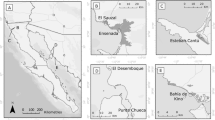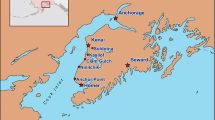Abstract
Information is presented on fishing effort, efficiency, techniques, and catch composition for Pumé men, women, and children along with a conceptual model of fishing as a food procurement strategy. The Pumé are a native lowland South American group living in the topical savanna region of southwestern Venezuela characterized by seasonal flooding. Results are discussed in relation to the Pumé environmental and social situation, and briefly compared with results from other lowland South American groups.
Similar content being viewed by others
References
Andel, T. van, and Postma, H. (1954). Recent sediments of the Gulf of Paria: Reports of the Orinoco Shelf Expedition. Verhandelingen der Koninklijke Nederlandse Akademie van Wetenschappen Afd.Natuurkunde 20.
Århem, K. (1976). Fishing and hunting among the Makuna.El Dorado 2: 37–54.
Baksh, M. (1985). Faunal food as a “limiting factor” on Amazonian cultural behavior: A Machiguenga example.Research in Economic Anthropology 7: 145–175.
Beckerman, S. (1983). Optimal foraging group size for a human population: The case of Bari fishing.American Zoologist 23: 283–290.
Beckerman, S. (1987). Swidden in Amazonia and the Amazon rim. In Turner, B. L., II, and Brush, S. B. (eds.),Comparative Farming Systems. The Guilford Press, New York, pp. 55–94.
Beckerman, S. (1989). Hunting and Fishing in Amazonia: Hold the Answers; What Are the Questions? Paper presented at the Wenner-Gren Foundation Conference titled “Amazonian synthesis: An integration of disciplines, paradigms, and methodologies.” Nova Friburgo, Rio de Janeiro, Brazil, June 2–10.
Beckerman, S., and Sussenbach, T. (1983). A quantitative assessment of the dietary contribution of game species to the subsistence of South American tropical forest peoples. In Clutton-Brock, J., and Grigson, C. (eds.),Animals and Archaeology: I. Hunters and Their Prey. B.A.R. International Series 163: 337–350.
Borgerhoff-Mulder, M., and Caro, T. M. (1985). The use of quantitative observational techniques in anthropology.Current Anthropology 26: 323–335.
Carvallo, G. (1985).El Hato Venezolano: 1900–1980. Fondo Editorial Tropykos, Caracas.
Chernela, J. M. (1985). Indigenous fishing in the neotropics: The Tukanoan Uanano of the blackwater Uaupes river basin in Brazil and Colombia.Interciencia 10: 78–86.
Chernela, J. M. (1989). Managing rivers of hunger: The Tukano of Brazil. In Posey, D. A., and Balée, W. (eds.),Resource Management in Amazonia: Indigenous and Folk Strategies. The New York Botanical Garden, Bronx, New York, pp. 238–248.
Cummins, K. W. (1988). The study of stream ecosystems: A functional view. In Pomeroy, L. R., and Alberts, J. J. (eds.),Concepts of Ecosystem Ecology: A Comparative View. Springer-Verlag, New York, pp. 247–262.
Denevan, W. M., and Schwerin, K. H. (1978). Adaptive strategies in Karinya subsistence, Venezuelan Llanos.Antropológica 50: 3–91.
Dunbar, R. I. M. (1989). Ecological modelling in an evolutionary context.Folia Primatologica 53: 235–246.
FAO. (1965).Soil Survey of the Llanos Orientales, Colombia. United Nations Special Fund, Rome.
Frost, I., and Miller, M. C. (1987). Late Holocene flooding in the Ecuadorian rain forest.Freshwater Biology 18: 443–453.
Gillin, J. (1936). The Barama River Caribs of British Guiana.Papers of the Peabody Museum of American Archaeology and Ethnology, Vol. 14, No. 2.
Gragson, T. L. (1989).Time Allocation of Subsistence and Settlement in a Ciri Khonome Pumé Village of the Llanos of Apure, Venezuela. University Microfilms International, Ann Arbor, Michigan.
Gragson, T. L. (1990). Seasonal Variance in Fish Catch Size and Catch Composition Among the Pumé. Paper presented at the 6th International Council for Archaeozoology, Washington, D.C., May 21–25.
Gragson, T. L. (1991). Life in the Forest and Life in the Savanna: Decisions Lowland South American Foragers Have Made. Paper read at the 90th Annual Meeting of the American Anthropological Association, November 20–24, Chicago, Illinois.
Gragson, T. L. (1992a) Fishing the waters of Amazonia: Native subsistence economies in a tropical rainforest.American Anthropologist 94: 428–440.
Gragson, T. L. (1992b). The Behavior and Productivity of Fishing Among Adult Pumé Men in Southwestern Venezuela (manuscript in preparation).
Gragson, T. L. (1992c). The use of palms by the Pumé Indians of southwestern Venezuela.Principes 36: 133–142.
Gragson, T. L. (n.d.a). The Ley de Llano and its effect on domestic production and autonomy of native villages in southwestern Venezuela. In Brumfiel, E. (ed.),The Economic Anthropology of the State. University Press of America, Lanham, Maryland (in press).
Gragson, T. L. (n.d.b). Subsistence ecology of the Pumé in a tropical wet savanna: The allocation of time to food search and procurement. In Lanata, J. L. (ed.),Faunal Resources: Exploitation Strategies in American Prehistory, B.A.R. International Series (in press).
Gragson, T. L., and Tillett, S. (n.d.). Aportes a la etnobotánica de Venezuela: 2. Etnobotánica de los Pumé.Ernstia (in review).
Gumilla, P. J. (1970). Escritos Varias del P. Jose Gunilla. P. José del Key Fajardo (ed.), Biblioteca de la Academia Nacional de la Historia No. 94, Italgráfica, Caracas.
Hames, R. B. (1979). A comparison of the efficiencies of the shotgun and the bow in neotropical forest hunting.Human Ecology 1: 219–252.
Harnes, R. (1989). Time, efficiency, and fitness in the Amazonian protein quest.Research in Economic Anthropology 11: 43–85.
Hames, R. B., and Vickers, W. T. (1983). Introduction. In Hams, R. B., and Vickers, W. T. (eds.),Adaptive Responses of Native Amazonians. Academic Press, New York, pp. 1–26.
Hawkes, K. (1990). Why do men hunt? Benefits for risky choices. In Cashdan, E. (ed.),Risk and Uncertainty in Tribal and Peasant Economies. Westview Press, Boulder, Colorado, pp. 145–166.
Hill, K. (1988). Macronutrient modifications of optimal foraging theory: An approach using indifference curves applied to some modern foragers.Human Ecology 16: 157–197.
Hill, K., and Hawkes, K. (1983). Neotropical hunting among the Aché of eastern Paraguay. In Hames, R. B., and Vickers, W. T. (eds.),Adaptive Responses of Native Amazonians. Academic Press, New York, pp. 139–188.
Hurtado, A. M. (1985).Women's Subsistence Strategies Among Aché Hunter-Gatherers of Eastern Paraguay. University Microfilms International, Ann Arbor, Michigan.
Hurtado, A. M., and Hill, K. (1990). Seasonality in a foraging society: Variation in diet, work effort, fertility, and sexual division of labor among the Hiwi of Venezuela.Journal of Anthropological Research 46: 293–346.
Kaplan, H., and Hill, K. (1985). Food sharing among Aché foragers: Tests of explanatory hypotheses.Current Anthropology 26: 223–239.
Kirchoff, P. (1948). Food-gathering tribes of the Venezuelan Llanos. In Steward, J. H. (ed.),Handbook of South American Indians (Vol. 4). U.S. Government Printing Office, Washington, D. C., pp. 445–468.
Koehl, M. A. R. (1989). Discussion: From individuals to populations. In Rougharden, J., May, R. M., Levin, S. A. (eds.),Perspectives in Ecological Theory. Princeton University Press, Princeton, pp. 39–53.
Lowe-McConnell, R. H. (1964). The fishes of the Rupununi savanna district of British Guiana, South America. Part 1. Ecological groupings of fish species and effects of the seasonal cycle on the fish.Journal of the Linnean Society of London, Zoology 45: 103–144.
Lowe-McConnell, R. H. (1987).Ecological Studies in Tropical Fish Communities. Cambridge University Press, Cambridge.
MAC (1959).Recursos Agricolas, Pecuarios y Forestales del Estado Apure. Caracas.
Machado, A. (1987).Los Peces de los Llanos de Venezuela: Un Ensayo Sobre su Historia Natural. Universidad Central de Venezuela, Caracas.
Mago, F. (1967). Notas preliminares sobre los peces de los Llanos de Venezuela.Boletin de la Sociedad de Ciencias Naturales 27: 237–263.
Mago, F. (1970). Estudios preliminares sobre la ecología de los peces de los Llanos de Venezuela.Acta Biológica Venezuélica 7: 71–102.
Martin, P., and Bateson, P. (1986).Measuring Behaviour: An Introductory Guide. Cambridge University Press, Cambridge.
Moran, E. F. (1990). Levels of analysis and analytical level shifting: Examples from Amazonian ecosystems research. In Moran, E. F. (ed.),The Ecosystem Approach in Anthropology: From Concept to Practice. University of Michigan Press, Ann Arbor, pp. 279–308.
Morey, N. C. (1975).Ethnohistory of the Colombian and Venezuelan Llanos. University Microfilms International, Ann Arbor.
Neter, J., Wasserman, W., and Kutner, M. H. (1985).Applied Linear Statistical Models. Richard D. Irwin, Homewood, Illinois.
O'Neill, R. V. (1989). Scale and coupling in ecological systems. In Roughgarden, J., May, R. M., Levin, S. A. (eds.),Perspectives in Ecological Theory. Princeton University Press, Princeton, pp. 140–156.
Petrullo, V. M. (1939). The Yaruros of the Capanaparo river, Venezuela.Bureau of American Ethnology, Bulletin 123: 161–290.
Pullum, G. K., and Ladusaw, W. A. (1986).Phonetic Symbol Guide. The University of Chicago Press, Chicago.
Räsänen, M., Salo, J. S., and Kalliola, R. J. (1987). Fluvial perturbance in the western Amazon basin: Regulation by long-term sub-Andean tectonics.Science 238: 1398–1401.
Rivero, P. J. (1956).Historia de las Misiones de los Llanos de Casanare y los Rios Orinoco y Meta. Editorial Argra, Bogota.
Sail, J. P. (1985). Procedure: NPAR1WAY. In SAS Institute (ed.),SAS User's Guide: Statistics. SAS Institute, Cary, North Carolina, pp. 607–614.
Schindler, J. E. (1988). Freshwater ecosystems: A perspective. In Pomeroy, L. R., and Alberts, J. J. (eds.),Concepts of Ecosystem Ecology: A Comparative View. Springer-Verlag, New York, pp. 57–74.
Sibly, R., and McFarland, D. (1976). On the fitness of behavior sequences.American Naturalist 110: 601–617.
Siegel, S. (1956).Nonparametric Statistics for the Behavioral Sciences. McGraw-Hill Book Company, New York.
Smith, E. A. (1991).Inujjuamiut Foraging Strategies: Evolutionary Ecology of an Arctic Hunting Economy. Aldine de Gruyter, New York.
Stephens, D. W. and Krebs, J. R. (1986).Foraging Theory. Princeton University Press, Princeton, New Jersey.
Steward, J. H. (1949). South American cultures: An interpretive summary. In Steward, J. H. (ed.),Handbook of South American Indians (Vol. 5). U.S. Government Printing Office, Washington, D.C., pp. 669–772.
Stewart, J. H. (1955).Theory of Culture Change: The methodology of multilinear evolution. University of Illinois Press, Chicago.
Stocks, A. (1983). Cocamilla fishing: Patch modification and environmental buffering in the Amazon vŕzea. In Hames, R. B., and Vickers, W. T. (eds.).Adaptive Responses of Native Amazonians. Academic Press, New York, pp. 239–267.
Tamayo, F. (1987).Los Llanos de Venezuela. Monte Avila Editores, Caracas.
Tooby, J., and DeVore, I. (1987). The reconstruction of hominid behavioral evolution through strategic modeling. In Kinzey, W. G. (ed.),The Evolution of Human Behavior: Primate Models. State University of New York Press, Albany, pp. 183–237.
Vickers, W. T. (1984). The faunal components of lowland South American hunting kills.Interciencia 9: 366–376.
Welcomme, R. L. (1979).Fisheries Ecology of Floodplain Rivers. Longman, London.
Winemiller, K. O. (1989). Development of dermal lip protuberances for aquatic surface respiration in South American characid fishes.Copeia 2: 383–390.
Yde, J. (1965). Material culture of the WaiWái.Nationalmuseets Skrifter Etnografisk Roekke 10.
Yost, J. A., and Kelly, P. M. (1983). Shotguns, blowguns, and spears: The analysis of technological efficiency. In Hames, R. B., and Vickers, W. T. (eds.),Adaptive Responses of Native Amazonians. Academic Press, New York, pp. 189–224.
Zinck, A. (1986).Venezuelan Rivers. Lagoven, S. A., Caracas.
Author information
Authors and Affiliations
Rights and permissions
About this article
Cite this article
Gragson, T.L. Strategic procurement of fish by the pumé: A South American “fishing culture”. Hum Ecol 20, 109–130 (1992). https://doi.org/10.1007/BF00889698
Issue Date:
DOI: https://doi.org/10.1007/BF00889698




